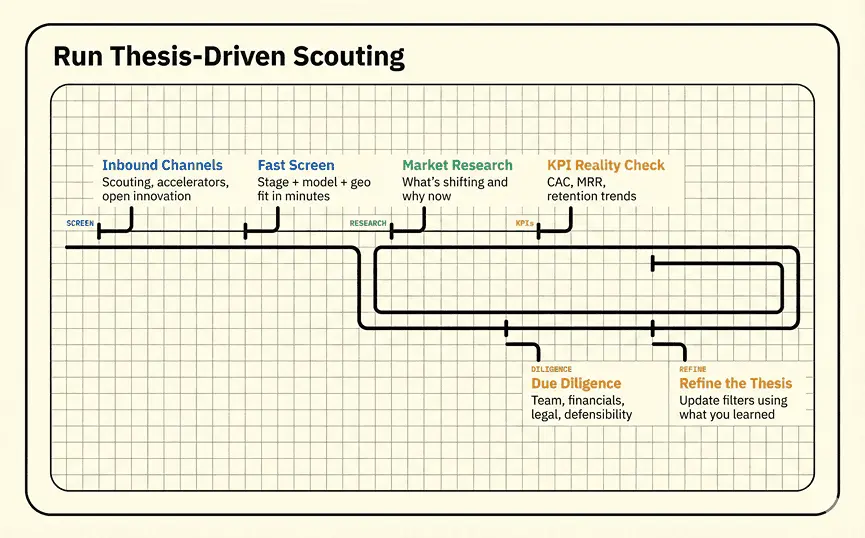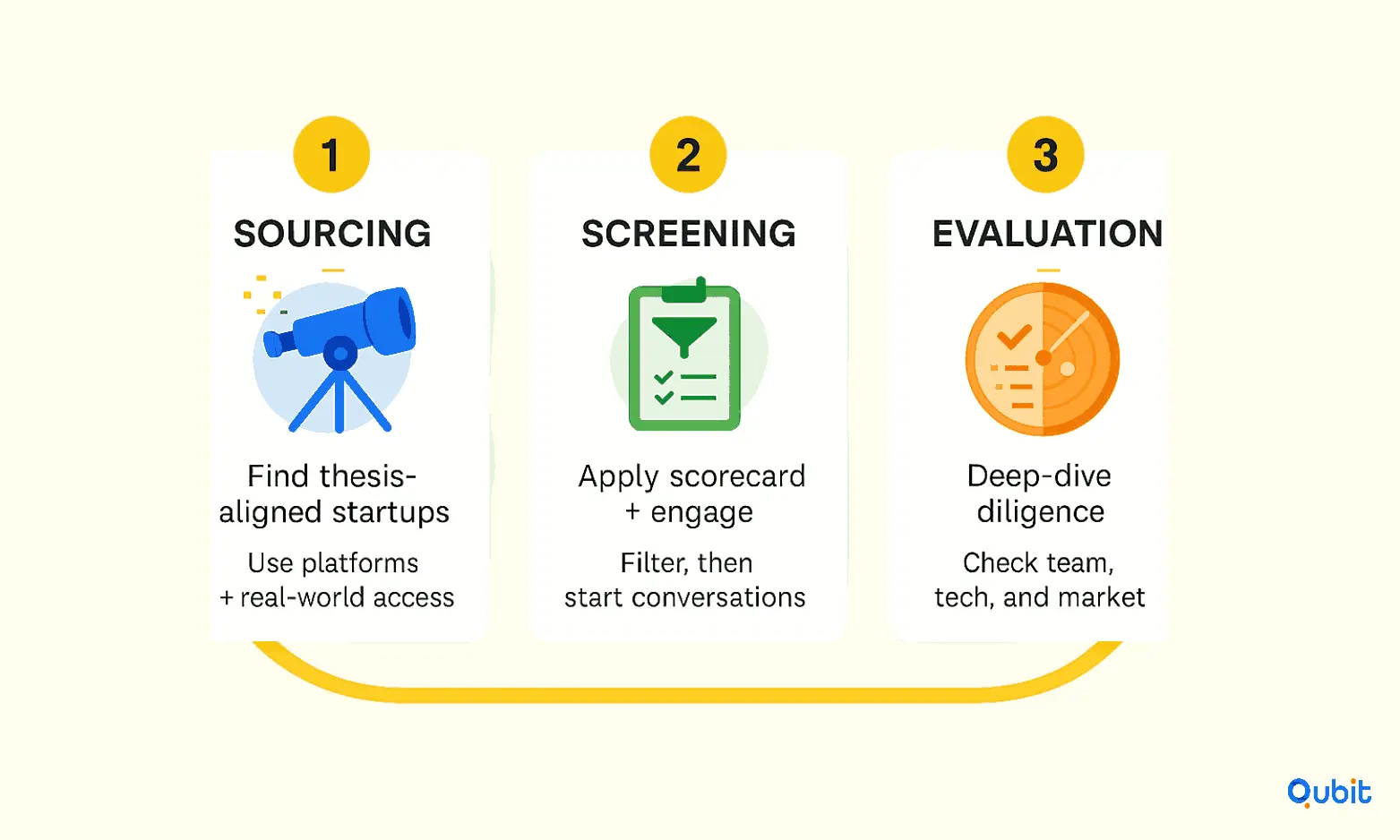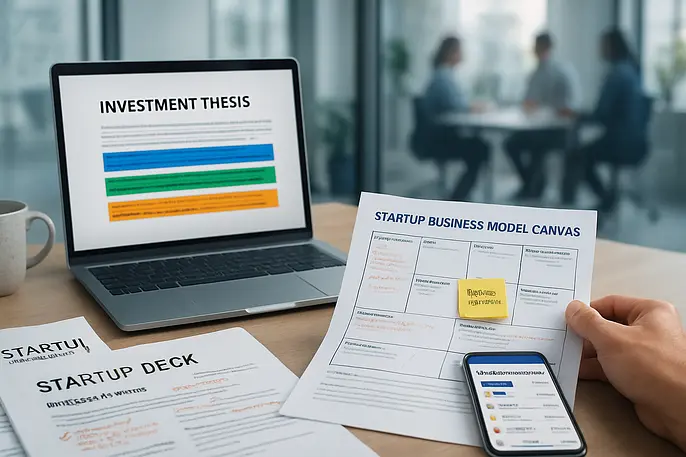An investment thesis is your decision filter. It turns “interesting startup” into a clear yes or no based on what you actually want. When your criteria are defined upfront, you spend less time chasing shiny pitches and more time finding teams that match your strategy, values, and risk appetite.
That focus matters in a crowded market. With global startup funding at roughly 314–330 billion USD in 2024 and 25,000 funding rounds completed, a growing share of those rounds include corporates or CVCs who first met the startup through a scouting, accelerator, or open-innovation channel.
A strong thesis helps you move faster in those channels, without losing discipline. Next, you will learn how to build your thesis, research markets, and run due diligence to find startups that truly fit your vision.
Understanding the Investment Thesis
An investment thesis is a clear set of rules that helps you choose startups that match your strategy. It keeps your decisions consistent, so you are not reacting to hype or chasing whatever is trending this week.
What An Investment Thesis Includes
At its core, an investment thesis spells out what you believe about the market and what you want to back. It usually defines:

- Target sectors
- Business models
- Stages
- Geographies
- The outcomes you want, including impact goals or exit goals
This clarity is what separates disciplined investors from those who follow trends without conviction.
Example Of Thesis Criteria In Action
For example, an investor targeting FinTech might choose a startup with MRR above $40K and customer acquisition across three continents. That kind of filter makes it easier to say no quickly and focus on deals that fit.
Funding Rounds and Market Analysis
In 2024 alone, over $330 billion was invested across 25,000 funding rounds. That volume creates a real problem: too many options, too little time. A thesis gives you a system to filter the noise and focus on what matters.
Why Data And Tech Now Matter More
Modern scouting is increasingly data-driven. Investors can track market signals, category momentum, and company performance faster than before. That is useful, but it only works if you already know what you are looking for.
Sector Velocity Shows Why Focus Matters
AI and machine-learning companies captured $131.5 billion in 2024. This accounted for nearly 58% of all VC money in Q1 2025. That kind of concentration is exactly why a thesis helps. It lets you decide whether you want exposure to high-velocity sectors, or whether you prefer categories that are less crowded.
Your thesis should also reflect your values and your view of market fit. Investing in areas that match your principles, or where product-market alignment is clear, often leads to stronger conviction and better decisions. A discussion of high-growth startup sectors reveals emerging market trends that align with your investment thesis, adding industry-specific context that enhances the subsequent analysis.
Translating Your Thesis Into Scouting Criteria
A thesis is only useful if it becomes a checklist you can apply in real conversations. Start by turning your thesis into a few objective filters, so you can qualify or disqualify startups quickly and consistently.
1. Stage
Decide which stage you want to play in, because the risk, timelines, and proof levels are different.
- Pre-seed: idea and early signals
- Seed: early traction and repeatability
- Late-stage: scale, efficiency, and defensibility
2. Business Model
Write down which models fit your strategy and why. Examples include SaaS, marketplace, usage-based pricing, hardware-enabled software, or services-as-a-wedge. This keeps you from funding a great team in a model you do not actually like.
3. Geography
Set your sourcing boundaries upfront. Are you focused on one market, a few regions, or global deal flow? Geography affects everything: hiring, go-to-market motion, regulation, and exit paths.
4. Impact Metrics
Define the milestones that make a startup relevant for you. These can be customer, product, or market signals, like retention thresholds, key partnerships, regulatory approvals, or proof of repeatable distribution.
5. Sector And Technology
Define the industries and technologies you want exposure to, and the reason behind it. Be specific. “AI” is not a sector. “AI for claims automation in insurance” is.
Using Benchmarks To Calibrate Your Filters
Benchmarks help you avoid unrealistic expectations and build cleaner filters. Median seed deal size stands at $3.1 million for 2024, with pre-money valuations averaging $12 million. Use this as a grounding point when evaluating whether a startup’s round size, pricing, and traction claims match the stage they say they are in.
A mention of startup scouting strategies situates a high-level framework that connects overarching investment theories with an effective startup evaluation process, complementing the deeper insights provided elsewhere. For investors, combining a well-crafted thesis with actionable strategies ensures a more targeted and efficient scouting process.
Market Research and Dynamics
Market research is how you stop guessing and start filtering. It shows you what is changing, who is winning, and where new opportunities are opening up. Without it, scouting becomes a game of vibes and LinkedIn hype.
What Market Research Should Tell You
Strong research helps you answer a few practical questions:
- What shift is happening right now, and why does it matter?
- Which customer problem is getting more urgent?
- What new technology or behavior change is making a solution possible now?
- Where are margins improving because models are getting leaner?
This is where trends like AI-driven solutions matter, but only when you connect them to a clear customer job and a real business model. Comprehensive market research for startups uncovers critical trends and competitive forces that shape your investment thesis.
Spotting Disruption Signals
Startups often win because they ride a change that incumbents move too slowly to catch. That change usually comes from:
- Shifts in customer behavior
- New capabilities in technology
- Clear gaps in what the market currently offers
Your job is to identify whether the startup is surfing a wave, or trying to create one from scratch.
Understanding The Competitive Landscape
A good opportunity can still be a bad deal if the market is crowded, distribution is locked up, or switching costs are low. Competitive analysis helps you judge:
- How many credible competitors exist, and how fast they are moving
- What makes this startup meaningfully different
- Whether it has a path to defend its position over time
How Stage Changes What You Look For
Market dynamics matter at every stage, but the proof you need changes.
- Early stage: you are looking for a sharp wedge, speed of learning, and signs of pull from the market
- Late stage: you are looking for efficiency, predictability, and defensibility at scale
When you track trends and competitive forces with this lens, your thesis gets sharper and your scouting gets faster. An overview of early vs late stage startup investing contrasts the distinct investment phases, offering clarity on how varied entry points integrate with your strategic vision.
Key Performance Indicators and Evaluation
Picking the right KPIs is how you separate a promising story from a scalable business. The goal is not to collect metrics. The goal is to track the few numbers that explain growth efficiency, revenue quality, and customer pull.
Core KPIs To Track
A strong baseline set includes:
- Customer acquisition cost (CAC): the cost to acquire one customer
- Monthly recurring revenue (MRR): predictable monthly income
- Retention rate: how many customers keep using or paying over time
Together, these metrics answer three investor-grade questions:
- Are you acquiring customers efficiently?
- Is revenue predictable and compounding?
- Are customers staying because the product delivers value?
Match KPIs To The Startup Stage
The same metric can be useful at any stage, but what you prioritize should change.
Early-stage startups often focus on CAC because it forces discipline around acquisition experiments and channel efficiency. At this stage, the biggest risk is spending without learning.
Growth-stage companies usually shift attention toward MRR and retention. These metrics show whether revenue is durable and whether the company can scale without leaking customers as fast as it acquires them.
Why Objective KPIs Matter
There is a big gap between ambition and outcomes. Only 6% of executives are satisfied with their innovation performance, even though 96% say innovation is a strategic priority. That mismatch is exactly why investors rely on measurable KPIs and regular evaluation instead of optimistic narratives.
Use Data To Validate, Not To Decorate
Data-driven analysis helps you test assumptions early and reduce downside risk. If CAC is rising, retention is falling, or MRR growth is slowing, the KPI trend tells you where the business is breaking before the pitch deck does.
If you want to go one level deeper, connect KPI evaluation to startup scouting mistakes. It helps you spot patterns like over-indexing on top-line growth, ignoring retention quality, or trusting vanity metrics that do not predict long-term performance.
Due Diligence and Thesis Refinement
Thoroughly evaluating a startup’s potential requires a meticulous due diligence process that examines every critical aspect of the business. This begins with gathering comprehensive information about the market landscape, the startup’s competitive positioning, and its growth trajectory.

Market analysis helps identify trends, customer needs, and potential risks, while team reviews assess the leadership’s expertise, vision, and ability to execute. Financial reviews, on the other hand, provide insights into the startup’s revenue model, cash flow, and scalability. Legal assessments ensure compliance and uncover any liabilities that could impact the investment.
Equally important is the continuous refinement of your investment thesis. This iterative process involves integrating feedback, reassessing assumptions, and aligning findings with your overall strategy. By doing so, you reduce uncertainty and enhance the quality of your decisions. For a deeper understanding of foundational principles, the section on startup scouting fundamentals presents the core principles integral to your approach, linking basic concepts with the more nuanced strategies outlined in this guide.
Startup Scouting Strategies and Tools
Identifying high-potential startups requires a blend of precision and adaptability. By combining advanced technological tools with human expertise, scouting efforts can achieve greater accuracy and efficiency. Hybrid models, which integrate automated data analysis with expert validation, are particularly effective in filtering and assessing emerging ventures.
The Strategic Role of Venture Scouts
Building on these hybrid approaches, engaging external venture scouts can significantly expand your deal flow. Venture scouts leverage their diverse networks to identify promising startups that may not appear on mainstream platforms. Their early access and sector expertise often uncover hidden opportunities, providing investors with a competitive edge. Integrating scouts into your strategy complements technology-driven methods and enhances overall scouting effectiveness.
Tools like Crunchbase simplify initial research by offering quick insights into potential investment targets, while CB Insights provides detailed analytics and market data to evaluate startups comprehensively. These platforms enable strategic filtering, ensuring that scouts focus on ventures with the highest growth potential.
Best Practices for Venture Scout Programs
- Recruit scouts from diverse backgrounds with strong industry networks to maximize deal sourcing potential and sector coverage.
- Offer clear incentives such as carried interest, profit sharing, or equity to motivate high-quality referrals and ongoing engagement.
- Provide continuous training and regular feedback to ensure scouts stay aligned with your investment thesis and evolving market trends.
Additionally, frameworks such as the “Strategic Buckets Model” help allocate scouting resources effectively, ensuring balanced attention across various sectors or startup stages. This structured approach minimizes the risk of overlooking promising opportunities while optimizing resource utilization.
A practical example highlights how strategy elevates outcomes. Chronicle attracted $7.5M in seed funding from leading VCs like Accel. Their approach combined rigorous storytelling with effective use of scouting frameworks, illustrating that narrative excellence can drive substantial investment even in competitive sectors.
By combining technology-driven insights with the nuanced judgment of experienced professionals, startup scouting becomes a more refined and impactful process.
Scouting Startups: Step-by-Step Approach

a. Sourcing Candidates Aligned to Your Thesis
- Databases and Platforms: Use tools like Crunchbase, PitchBook, and curated startup platforms to search for companies that match your predefined sectors, funding stages, and geographies.
- Events and Networks: Attend targeted industry events, accelerator demo days, and niche conferences to meet startups and access beta opportunities before they become widely visible.
- Accelerators and Incubators: Partner with programs focused on your chosen industries for early insights into high-potential ventures.
b. Initial Screen and Engagement
Apply your thesis-driven scorecard: filter out startups that don’t meet your baseline requirements. For those that do, initiate conversations and request more in-depth data, such as pitch decks, product demos, or customer feedback.
c. In-Depth Evaluation
For thesis-aligned prospects, conduct thorough due diligence:
- Market size and growth potential
- Competitive analysis (Does this startup fill a genuine gap?)
- Team capabilities and experience
- Scalability and technology differentiation
Regularly updating your scorecard and criteria as markets evolve ensures your thesis stays relevant and effective
Benefits of Building an Investment Thesis
1. Focused Pipeline
By using your investment thesis as a strict filter, you narrow down your deal flow to startups that truly align with your strategic criteria. This eliminates distractions caused by opportunities that don’t fit your sectors, business models, or stages of interest. Instead of being spread thin and evaluating numerous irrelevant or misaligned startups, you concentrate your time and resources on prospects that have the potential to succeed within your defined framework. This focus not only improves your efficiency but also boosts the quality of your pipeline by increasing the likelihood of finding truly promising investments.
Thesis-driven access strategies can broaden pipelines. Alumni Ventures is reducing barriers with a $10,000 minimum investment for seed deals. This opens curated startup deal flow to more investors, demonstrating operational pipeline focus in action.
2. Increased Efficiency
A thesis-driven approach often involves creating clear, objective criteria and scorecards based on your investment thesis. This systematization allows you to quickly screen startups by scoring them against predefined parameters such as market size, team strength, product fit, and growth potential. Rather than relying on subjective impressions or ad hoc evaluations, you quantify factors and prioritize startups that score highest against your thesis metrics. This structured vetting accelerates decision-making, reduces cognitive overload, and ensures consistency across all deal evaluations, resulting in a more manageable and high-potential deal pipeline.
3. Better Portfolio Fit
Investments aligned with your thesis tend to synergize well with your core strengths and resources. When startups fit your targeted sectors or business models, you are better positioned to add value beyond capital—whether through mentorship, strategic guidance, industry connections, or operational support. Additionally, thesis alignment ensures your portfolio maintains a coherent risk and reward profile that matches your investment preferences. Instead of having a scattered, unfocused portfolio, your holdings complement each other and participate in similar growth trajectories, maximizing your ability to guide companies and optimize returns.
4. Clear Communication
When you have a clearly articulated investment thesis, you convey a professional, disciplined approach to founders and entrepreneurs. Startups appreciate knowing why you are interested in their company—because it fits a stated focus area, stage, or value proposition—rather than guessing or facing generic outreach. This clarity builds trust and transparency, encouraging stronger relationships and better alignment in expectations. Founders are more likely to engage deeply, share information openly, and view you as a strategic partner, which enhances due diligence quality, speeds up negotiations, and often improves the terms of the deal. Furthermore, a clear thesis helps you build a positive reputation in your niche, attracting inbound deal flow from startups that specifically seek investors who understand their space.
Regulatory, Compliance, and Future Trends
The startup investment landscape is undergoing a transformation, driven by evolving regulatory compliance in startups and the integration of cutting-edge technologies. Investors must now account for dynamic regulatory frameworks that demand agile and compliant scouting strategies. These changes are not just about adhering to rules but also about staying ahead in a competitive market.
Emerging trends like Environmental, Social, and Governance (ESG) considerations are reshaping investment theses. ESG integration is increasingly becoming a decisive factor for startups seeking funding, as investors prioritize sustainability and ethical practices. Additionally, AI-driven analytics are revolutionizing how opportunities are identified and evaluated.
Conclusion
Integrating a well-defined investment thesis with targeted startup scouting strategies can significantly enhance decision-making for investors. By focusing on key areas such as thesis development, thorough market research, KPI evaluation, and meticulous due diligence, investors can identify opportunities that align with their goals while minimizing potential risks. A systematic, data-driven approach ensures that every step of the process is backed by actionable insights, ultimately leading to more informed and confident investment outcomes.
If you're ready to transform your investment thesis into actionable startup scouting insights, we at Qubit Capital are here to assist you with our Startup Scouting service.
Key Takeaways
- A well-crafted investment thesis is essential for identifying high-potential startups.
- Robust criteria, market research, and KPI evaluations underpin effective startup scouting.
- Data-driven due diligence minimizes risk and refines investment strategies.
- Leveraging advanced tools and frameworks enhances accuracy in startup evaluation.
- Incorporating these strategies can transform your investment approach and outcomes.
Frequently asked Questions
What is an investment thesis?
An investment thesis is a strategic document outlining criteria and reasoning to select startups that best match your investment goals and values. It guides decision-making.






